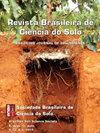Adapting the land agricultural suitability assessment scheme for drylands edaphoclimatic conditions
IF 2
4区 农林科学
Q3 SOIL SCIENCE
引用次数: 0
Abstract
The rational exploitation of the land requires planning its agricultural use, which can be supported by the agricultural land suitability (ALS) assessment. The scheme to assess ALS proposed by Food Agricultural Organization (FAO) has been adopted in Brazil based on guiding charts for subtropical, humid tropical and semi-arid tropical climate. However, the guiding chart used for the semi-arid region has dramatically limited the ALS in drylands on which rainfed agriculture has been practiced. In this study, an adequation for the ALS assessment regarding the edaphoclimatic conditions of semi-arid region was proposed to improve the representation of agricultural areas and to allow a better planning of soil conservation practices. The ALS of the south region of Ceará State (Brazil) was assessed according to the FAO scheme and its initial adaptation to the Brazilian conditions; subsequently, this assessment was obtained by two adequations. Adequation I disregarded the limiting factor of water availability, while adequation II, besides disregarding the factor of water availability, established new limits for the classes of effective soil depth. The adequations resulted in an increase of 177.19 % in the areas with regular suitability for crops to the detriment of areas with restricted suitability for crops and areas with suitability only for pasture or grazing lands. The adequations increased the agricultural suitability in 41.26 % of the area of the mapping units, and 16.77 % of them were due to the modifications related to the effective soil depth, while the other 26.35 % were due to the changes related to water availability. The results related to water availability were equivalent to those observed through the dynamic analysis of land-use and cover associated with the rainfall, which demonstrated an increase in the areas for rainfed agriculture and a reduction in fallow and pasture areas in the years with rainfall within the climatic normality. The areas considered suitable for crop production with the adequation of the scheme may be included in soil conservation programs.适应旱地气候条件的土地农业适宜性评价方案
合理开发利用土地需要对土地进行农业利用规划,而农业用地适宜性评价是土地利用规划的重要支撑。巴西采用了粮农组织提出的基于亚热带、湿润热带和半干旱热带气候指导图的ALS评估方案。然而,用于半干旱地区的指导图极大地限制了旱地的ALS,旱地实行雨养农业。在本研究中,提出了半干旱区土壤气候条件的ALS评价的不足之处,以提高农业地区的代表性,并允许更好地规划土壤保持措施。根据粮农组织计划及其对巴西条件的初步适应,对塞埃尔州(巴西)南部地区的ALS进行了评估;随后,这一评价是由两个不足得到的。充分I不考虑水分有效度的限制因素,而充分II在不考虑水分有效度因素的基础上,对土壤有效深度等级建立了新的限制。这些不足导致一般适宜种植作物的地区增加了177.19%,而限制适宜种植作物的地区和仅适合放牧或放牧的地区则受到损害。41.26%的填图单元面积的农业适宜性增加,其中16.77%是由于有效土壤深度的变化,26.35%是由于水分有效度的变化。与水供应有关的结果与通过与降雨有关的土地利用和覆盖的动态分析所观察到的结果相当,这表明在降雨在气候正常范围内的年份,雨养农业面积增加,休耕和牧场面积减少。在方案充分的情况下,认为适合作物生产的地区可列入土壤保持方案。
本文章由计算机程序翻译,如有差异,请以英文原文为准。
求助全文
约1分钟内获得全文
求助全文
来源期刊

Revista Brasileira De Ciencia Do Solo
农林科学-土壤科学
CiteScore
3.00
自引率
11.80%
发文量
32
审稿时长
9-24 weeks
期刊介绍:
The Revista Brasileira de Ciência do Solo is a scientific journal published by the Brazilian Society for Soil Science (SBCS), founded in 1947, and is responsible for the propagation of original and inedited technical-scientific work of interest for Soil Science.
Contributions must not have been previously published or submit to other periodicals, with the only exception of articles presented in summarized form at professional meetings. Literature reviews are accepted when solicited by the Editorial Board.
 求助内容:
求助内容: 应助结果提醒方式:
应助结果提醒方式:


